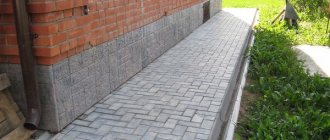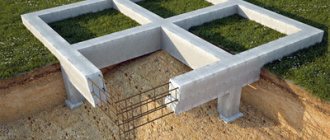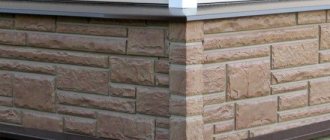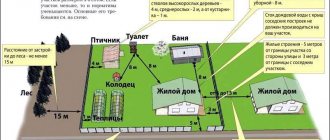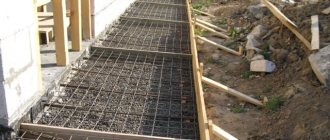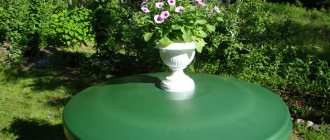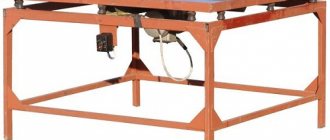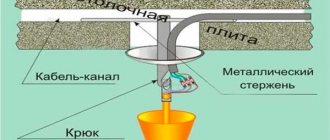The blind area is needed not only for beauty
After completing the construction of the well, the time comes for its arrangement, aimed at ensuring ease of use and maintaining the purity of the water. An important element of such arrangement is a soft blind area around the well, which will not allow melt and surface water to penetrate into the mine, and will provide you with a convenient approach to the structure. Why do many experts advise making a soft blind area, what other ways are there to create it, what are their advantages and disadvantages? All this will be discussed below.
When to do a blind area and whether to do it at all
Let's start with the question - why do we need a blind area? Mainly to prevent contaminated high water and melt water from seeping into the groundwater well from the surface of the earth. Her task is not to let them through to the mine shaft, to take them aside. One should not neglect the fact that a well with a blind area looks more aesthetically pleasing, and it is much more convenient to use it standing on a clean and dry foundation. However, the need for it may not arise if the following conditions are met:
- The well is located away from roads, industrial zones, in an environmentally friendly place;
- It stands on a hill, which prevents the flow of surface water to it;
- Equipped with automatic water-lifting equipment that does not require your frequent presence at the well.
Now about the best time to make a blind area. The instructions state that no earlier than a year after completion of construction, since during this time (and sometimes longer) self-compaction and settlement of the soil filled around the well shaft occurs, as a result of which voids and failures are formed.
Sinkholes around the new well
Also during this period, there may be a natural displacement of the upper rings of the well in the horizontal plane, which can also disrupt the integrity of the blind area. Therefore, its construction can be started only after these processes have been completed and their consequences have been eliminated.
Advice. In order to be able to use well water without fear during this time, during the construction of the structure it is necessary to make a clay castle and temporary blind area around it.
General stages of laying a blind area
Regardless of the material that will be used to construct the blind area, its organization scheme is simple. After the soil has settled, a working space is cleared around the well shaft and a trench is dug. The depth depends on the type of protective structure, and the diameter for hard and soft blind areas is almost the same.
The trench is filled with clay, cement mortar or bulk material, the surface is leveled and prepared for further finishing at the request of the owner. After construction work, you need to monitor the blind area in order to notice the appearance of damage in time.
Types of blind areas
The blind area at the well can be made of different materials: clay, concrete, reinforced concrete, as well as waterproofing film and sand. The latter is called a soft blind area. Let's look at the features of their device.
Solid types of blind areas
Made of clay or concrete with a thickness of 20-30 cm and a width of 1.2 to 2.5 meters along the entire perimeter of the structure:
- The clay blind area is a layer of compacted clay placed in a recess of the specified dimensions. Its main disadvantage is the formation of slippery and sticky dirt on the surface when water gets on it. This will require additional costs for the installation of a protective coating.
Clay blind area
- The concrete blind area of a well is made by pouring concrete into the formwork installed in the recess on a bed of gravel. To make it last longer, reinforcing mesh is placed in the formwork before pouring the solution. A prerequisite for the manufacture of such a blind area is waterproofing the outer walls of the well in the place where they will come into contact with the concrete. This is necessary to prevent rigid adhesion of the well ring to the frozen blind area slab.
Note. In any case, the blind area must have a slope from the well to drain water. Sometimes drainage grooves are also made in it.
Scheme of the concrete blind area
The disadvantage of this type is the frequent formation of chips and cracks on the surface. They not only allow surface water to pass through, but also give the concrete surface an unkempt appearance. However, this is not the biggest problem - if desired, the blind area for the well can be repaired. But it itself, if the manufacturing technology is not followed, can damage the well trunk and compromise its integrity. The fact is that the blind area is affected by the forces of frost heaving, and if it is rigidly connected to the upper ring of the well, it may be separated from the lower one. As a result, a gap is formed between them, through which contaminated water and soil particles fall directly into the mine with clean water.
The photo shows dirty streaks from the gap between the rings
Soft blind area
This structure consists of a waterproofing film, which is covered with a layer of sand. It is possible to install a decorative covering or lawn on top. Its production does not require large financial and physical costs and consists of the following steps:
- Before making a blind area around the well, fertile soil is removed around it to a width of 1.2-1.5 meters;
- A waterproofing film is placed at the bottom of the recess, the edge of which is placed on the upper ring;
Advice. As waterproofing, it is recommended to use a special frost-resistant film for laying in the ground, which is used in the construction of building foundations.
- The film is fixed to the ring using double-sided tape or a metal strip, through which it is attached to the walls with dowels or screws;
- At the point where the film transitions from a vertical to a horizontal position, a fold must be made. It is designed to compensate for displacement and subsidence of the soil in the base, which will prevent damage and destruction of the top decorative layer;
- Sand is poured onto the film, on top of which paving slabs, paving stones, bricks, crushed stone, etc. are laid. You can simply put back the previously removed turf or sow lawn grass.
Scheme of a soft blind area
Advantages of a soft blind area
In addition to the fact that manufacturing such a design in an economical version will require a minimum of effort, it has many other advantages:
- The most important thing is that there is no risk of the well shaft rupturing along the seam between the rings;
- The soil around the well can settle and compact without damage to both the well itself and the covering of the blind area;
- Low price of materials used;
- If it is necessary to repair the well, the soft blind area can be easily dismantled;
- A waterproofing film will do a much better job of draining water from the walls of a well than clay or concrete;
- Low labor intensity of the process - in this case, digging a well with your own hands is done without problems and without the involvement of assistants;
- Decent service life, reaching 80 years. Only the outer decorative layer may need repairs;
- Finally, you can use any decorative finish from wood decking to stone cladding.
Concrete well blind area
Cement mortar is an affordable consumable material that is widely used in construction and finishing work. To construct a concrete blind area, a solution is poured into the prepared trench. The bottom of the excavation is covered with a cushion of gravel, screenings or other material. For ease of work, it is advisable to install formwork.
The concrete blind area around the well should not harden as a monolith, being fastened to the walls of the head. Therefore, before pouring, the rings that will be in contact with the solution are wrapped in non-woven material (geotextile, roofing felt). This will prevent rupture of the upper rings during winter heaving of the soil.
The cement surface can be easily finished: laying with tiles, stone, flagstone. You can use any suitable material that usually remains in bins after construction or renovation.
The main disadvantage of a solid concrete blind area is cracking due to soil subsidence or soil expansion in frosty weather. To correct the damage, you will have to completely break and remove the frozen solution. To strengthen the blind area, a reinforcing mesh is laid inside the formwork. A rigid frame will prevent deformation.
There is no consensus on whether or not it is worth making a concrete blind area. There are cases when it becomes covered with cracks for the next season, and there are old wells where it remains intact for years.
The depth of the trench under the concrete blind area should be at least 30 cm; the softer and more pliable the soil, the deeper the pit needs to be dug, which reduces the risk of subsidence and destruction
We invite you to familiarize yourself with the Top 10 best septic tanks for home and garden in 2020 in the Zuzako rating
Digging and equipping a well constitute the technical part of the work being carried out, which is aimed at achieving a practical goal - to ensure water supply. Then comes the turn of refining the surrounding area, which gives it a complete look.
Here the field of activity for landscape designers opens up when the blind area becomes an organic part of the overall plan for arranging the estate. Before you begin the final stage of work, look at a photo of the blind area around the wells or its computer model to choose the most organic option based on the general concept and materials suitable for it.
Insert: will provide a large number of samples of the work we have completed, which will help you choose the style of the final arrangement of the source. We are also ready to bring any customer's ideas to life.
Our company specializes in creating individual water supply systems and offers a full range of services in this area. We promise reasonable prices and high quality results of our work with official guarantees.
Why is a blind area necessary?
It is not for nothing that SNiP standards recommend erecting small drainage systems around sewer hatches and wells. Their main function is protection, but in a suburban area you can decorate the space with the help of blind areas around the well. They can become an element of landscape design and help fit the aquifer structure into the surrounding space. In most cases, wells are made of concrete rings - a material that is not attractive in appearance. Every owner strives to decorate it.
Landowners build wells to have access to drinking water. All their efforts can be nullified if the structure is not equipped with protection from contamination and precipitation. During the spring thaw, water from a constructed well can mix with melt water. You won't be able to drink it until summer. Contaminants can enter the well along with wastewater. This can be: residues of fertilizers, feces, ash, sand, wood chips and other debris.
Another advantage of the blind area is that its use provides the owner with access to a source of water at any time of the year. It is almost impossible to approach the building on compacted soil after rain. If you do not remove the layer of fertile soil around the building, then not only dirt, but also grass will interfere with your work. It will have to be constantly mowed or trimmed.
When to start construction?
If you turn to SNiP, then immediately after equipping a well, a blind area is not built. This is due to the fact that the following processes occur during the year:
- the soil around becomes denser;
- voids around the building disappear;
- the concrete rings move slightly as the soil shrinks.
If you hurry and build the blind area earlier, then after a year it may become deformed. You will have to dismantle it and start work from scratch. This will lead to serious waste of time and effort.
Important! You can safely use well water immediately after the construction of the well is completed if you make a temporary cover and lock around it.
Proper soil preparation will help protect the aquifer from chemical and other contaminants. Around the well it is necessary to retreat up to one and a half meters; in this area it is necessary to remove a layer of soil up to 40 centimeters thick. Compact the soil in the resulting circle. The well shaft must be cleared of visible soil. It will be easier to do this if you used plastic to make it. Additionally, the site is treated with a herbicide, thanks to which weeds will stop growing on it - their roots will die in the soil.
After completing the preliminary work, you can begin constructing a temporary blind area from clay or erecting a permanent structure. You can refuse to carry out work only if the following conditions are met:
- a distance of at least 3 meters is maintained from the nearest road;
- the well is equipped with a pump;
- the well is located in an environmentally friendly area;
- the building is located on a hillock.
At the stage of preparing the well for work, you will have to create a project for decorating the space. Experienced builders recommend erecting a canopy over the site adjacent to the shaft of the aquifer structure. If pets will move freely around the area, build a fence.
It is necessary to take these points into account for proper site preparation. Due to the design, you will have to remove the soil so that the area is square or rectangular. During preparatory work, it may be necessary to make holes for supports for a canopy or fence.
Cost of blind area of a private house
In order not to be unfounded, we will give a brief comparative description, i.e. We will indicate in the table the prices for blind areas made of concrete and paving slabs. All prices for 2020, approximate, are presented for information purposes as a guide for drawing up estimates.
| Material | Material consumption per 1 sq.m. | Price | The cost of a concrete blind area per 1 sq.m. rub. | |
| Concrete M22, class B-15 | 1 | RUB 3,500 | 350 | |
| For self-preparing concrete | ||||
| per 1 cubic meter | For 1 sq.m. | |||
| Cement M 500 | 320 kg | 32 kg | 200 rub/50 kg | 128 |
| Screenings or crushed stone (fraction 5-10 mm) | 0.8 cubic meters | 0.08 cubic meters | 1800-2000 cubic meters (the price is also affected by the loading location: quarry or delivery) | 160 |
| Sand | 0.5 cubic meters | 0.05 cubic meters | 400-600 rub/m3 (the price is also affected by the loading location: quarry or delivery) | 30 |
| Water | 190 l | 19 l | At local rate | |
| Concrete additives* | ||||
| For pillow | ||||
| Geotextile, PVC film) | 1 sq.m. | 110-2500 rub/roll (50 sq.m.) | 100 | |
| Sand | 0.05-0.1 cubic meters Depending on the thickness of the layer and the composition of the finishing base for the tile | 400-600 rub./m3. | 25-50 | |
| Screenings or crushed stone (fraction 3-10 mm) | 0.1 cubic meters | 1800-2000 cubic meters (the price is also affected by the loading location: quarry or delivery) | 190 | |
| Reinforcement | ||||
| Fittings, diameter 6 mm. | 12 m.p. | 10 r/m.p. | 120 | |
| Reinforcing mesh 50x50, diameter 3 mm. | 1 sq.m. | 60 rub./piece (1000x2000) | 60 | |
| Reinforcing mesh 150x150, diameter 3 mm. | 1 sq.m. | 33 RUR/piece (500x2000) | 66 | |
| Formwork installation | ||||
| Boards for formwork** | ||||
| Beam 30x30 for spacers** | ||||
| Total: | ~ 800 rub/sq.m. | |||
* We are talking about additives (plasticizers) that give concrete additional properties (strength, frost resistance). The addition of plasticizers to the concrete mortar is at the discretion of the master. In the “classic” recipe given, their cost is not taken into account.
** to form the formwork when pouring a blind area, in practice, old boards or used plywood are used. Therefore, their cost is also taken into account.
| Material | Material consumption per 1 sq.m. | Price | The cost of a blind area made of paving slabs per 1 sq.m. rub. |
| For pillow | |||
| Clay | Depends on the soil and the desired thickness of the hydraulic lock 0.05-0.1 cubic meters. | 250-400 rub/m3 (depending on the location of the quarry and the fat content of the clay) | 15-30 |
| Geotextile, PVC film | 1 sq.m. | 110-2500 rub/roll (50 sq.m.) | 100 |
| Sand | 0.15-0.2 cubic meters Depending on the thickness of the layer and the composition of the finishing base for the tile | 400-600 rub/m3 | 75-100 |
| Screenings or crushed stone (fraction 3-10 mm) | 0.1 cubic meters | 1800-2000 cubic meters (the price is also affected by the loading location: quarry or delivery) | 190 |
| For the finishing layer | |||
| Cement M 500 | 10 kg. Depends on the purpose of the formwork | 500 rub/50 kg | 100 |
| Sifted sand | 2.5 - 10 kg. Depends on the purpose of the formwork | 100 rub/50 kg | 10 |
| For the front layer | |||
| Tile | Depends on the size of the tile. 50 pcs. for the “brick” shape | 300-1,500 RUR/pcs. on average 400 rubles. for the “brick” shape | 2000 |
| Border | 2 pcs. | 75-300 rub/piece. depending on thickness | 360 |
| Water for irrigation sands and blind areas | Before puddles form | At local rate | |
| Total: | ~ 3000 rub/sq.m | ||
The cost of work without material is given separately in the relevant articles on the installation of blind areas made of concrete and paving slabs.
We invite you to familiarize yourself with the design of a bathhouse in a modern style
An important point, based on the experience of constructing blind areas of various types, we can give the approximate time for the construction of each of them. The calculation was made based on the total time spent by one person on making a blind area of 50 square meters.
- Completion of all work on preparing the base, forming the formwork and pouring the concrete blind area takes approximately 40-50 minutes. per 1 sq.m. (20-25 minutes when using ready-made concrete).
- Filling the pillow and laying tiles 1 sq.m. takes 60-70 minutes. Moreover, a significant amount of time is spent on the process of compacting the base.
It should be noted that with increasing square meters (area), the speed of work increases.
What type of blind area should I choose?
Any foundation is built according to the following principles:
- a technological pause is maintained;
- excavation and preparatory work is being carried out;
- fractional material is laid;
- slope is planned;
- The final covering is being erected.
It cannot be said that one of the blind areas around the well will be better or worse. All design options have their own characteristics. Most often, experts recommend building a soft foundation. It does not compress the walls of the shaft, which eliminates displacement of the rings and clogging of the well. The soil can settle and shift. Over the years, you can complete the foundation without dismantling it. Absolutely any decorative covering can be laid on a soft base: from tree trunk cuts to paving slabs.
If you want to use the well without maintaining a technological pause, then the area around it can be equipped with dense soil. The mine is sprinkled with it at a slight slope. A wooden shield is knocked down from above, which will prevent this embankment from being washed away by precipitation. The well should be covered with a hatch, which can be made of boards, a sheet of metal or plastic.
Construction of a clay castle
Under any blind area it is necessary to lay a clay castle. It will prevent melt water or precipitation from entering the well shaft. You can strengthen the site with soft clay as a temporary option.
Important! A clay castle is always made in the spring. To do this, you need to choose a time when the soil has already thawed, but has not yet had time to settle.
During the summer, the soil settles significantly. If you make a castle in the fall, then in the spring it will be deformed. When constructing it, it is important to lay a slope that will divert melt water away from the well shaft. On three types of soil you can do without building a clay foundation: peat, sand or stone. If the soil settles significantly over the summer, then you don’t have to mount the lock at all.
Space for the lock must be left immediately after installation of the shaft. To do this, 50 centimeters are retreated from its rings and a pit 2.5 meters deep is left. Soft and greasy clay is placed in the prepared pit, it is compacted well. After completion of the work, it is necessary to leave the clay for a year.
Several years ago it was popular to completely cover the site with clay. But this method is now being abandoned, since on rainy days such a well area can become slippery. After a few years of use, the clay becomes uneven. Because of this, the well looks untidy. In order to completely cover the site with clay, it is necessary to lay this material over the entire prepared site in a layer of at least 20 centimeters.
External threats to clean well water
Master well builders must build and deliver a good working well, and the owner must ensure its further protection from contamination. The mine goes through several layers of filter rocks and opens a clean aquifer so that various runoff does not get into it; an insulating blind area is built around the head.
Previously, the blind area of a well made of clay was common - a clay castle. This method is still used today, but often craftsmen do not have an accurate idea of the correct laying or use the wrong breed. Because of this, negative reviews from clients and experienced builders have become more frequent.
We invite you to familiarize yourself with Elephant Tusk Radish
Often the blind area around the well is carried out according to the principle of pouring concrete around the perimeter of residential buildings. This is a simple and inexpensive method of protection against flooding or rainfall, but its reliability is not always at a satisfactory level.
The latest technology in well construction is soft blind area. It does not require expensive materials, it is quick and easy to install, and possible repair work will also not cause significant problems. Compared to the first two methods, the soft blind area around the well requires minimal labor costs. You can actually build it with your own hands.
There is an opinion that a blind area around a well is not necessary if it is located in an environmentally friendly area and the likelihood of dirty water getting in is minimized. It performs not only a protective, but also a decorative role, so the benefits of its arrangement justify the expenditure of labor and time.
Concreting the site
We will not dwell in detail on the disadvantages and advantages of concreting; most often this foundation is made if the well is not intended for the extraction of drinking water, but serves as a sewer hatch. If you choose this option for your site, then you can decorate it with stone and special tiles.
- Prepare a trench for laying the concrete pad. To do this, dig a ditch 30 centimeters deep, at the bottom of which 15 centimeters of sand are laid. Using a vibrator you need to compact this layer;
- At the next stage, fine crushed stone is poured into the pit in a layer of about 10 centimeters. It is also compacted;
- Wooden slats need to be lubricated with bitumen and laid so as to divide the circle of the blind area into segments. This will prevent the foundation from being destroyed in the next frosty winter.
- Place concrete on the site so that a slight slope is maintained. Carry out the alignment along the slats - their upper edge should coincide with the level of the concrete pad;
- The following procedure completes the work: cement is scattered onto a layer of wet concrete, which is smoothed with a trowel. This work must be repeated several times to make the platform more durable;
- Wet a rag and cover the area with it. Leave until the concrete hardens completely; the rags must be moistened regularly. This is done to make the concrete pad more durable.
Try to avoid rigid fixation of concrete to the shaft rings. When the soil swells, they can move under the influence of the weight of the concrete structure.
Requirements for the installation of a blind area in accordance with building codes
We invite you to familiarize yourself with Corner bathhouse with gazebo and barbecue
A blind area is a horizontal protective strip, 1–2 meters wide, durable and waterproof, often insulated, which runs along the perimeter of the entire building. Without fail, the blind area must be tightly adjacent to the outer vertical walls of the foundation or plinth and not allow water to pass through in the contact zone. It should be remembered that this role of the blind area is the main one, and not its aesthetic value.
Ideal pavement area
A blind area in one form or another is also necessary to protect the house (primarily from precipitation), just like its roof. The requirements of SNiP 2.02.01–83 are unambiguous: “...waterproof blind areas must be constructed around each building.”
Various designs of blind areas use a wide variety of materials for their construction. The general functional requirements for all types of blind areas are the same - strength, waterproofing, insulation.
“Type I - soil conditions in which subsidence from the soil’s own weight is absent or does not exceed 5 cm; subsidence is possible mainly from external load.
Type II - soil conditions in which, in addition to subsidence of soil from external loads, subsidence from its own weight is possible and its value exceeds 5 cm.”
The same document determines the width of the blind area according to GOST. For soils of the first type, it should not be less than 1.5 m, and for soils of the second type, the width of the blind area should not be less than 2 m.
When building on subsidence soils, it is necessary to take all measures to ensure that the foundation passes through the subsidence layer, plus the use of special construction technologies.
For normally load-bearing soils, regulatory documents determine the minimum width of the blind area to be 0.8–1.0 m. At the same time, its width must necessarily exceed the overhang of the roof above the walls by 20–30 cm.
The thickness (height) of the blind area is to a lesser extent standardized by SNiP. According to regulatory documents, after sampling the soil and plant layer across the entire width of the blind area, a base of clay, sand or crushed stone, at least 15 cm thick, is arranged and compacted. Next, hydro- and thermal insulation layers are laid.
The height of the blind area around the house (mark of the upper protective layer on the outer edge of the blind area) should rise above the “0” mark by at least 5 cm.
If the blind area according to the plan is pedestrian, then the requirements for it from regulatory documents increase in width and strength.
The slope of the building's blind area, according to SNiP, must be at least 10 ppm away from the building. This means that the slope per 1 meter of the blind area must be at least 1 cm in size. Typically, the slope of the blind area is 2–3 cm per 1 meter of the width of the blind area. The maximum slope, according to SNiP, should not exceed 10 cm per 1 m of blind area width. A too steep slope of the blind area will cause water flows to accelerate and gradual destruction of the outer edge of the blind area, at the border with the ground.
In some cases, water intake gutters are constructed on the outer border of the blind area, which set the longitudinal slope. Through these gutters, rainwater travels a considerable distance away from the building.
There are several ways to fill a blind area with a slope. The easiest way is to build and fill a horizontal blind area. After constructing the pit for the blind area, the leveling layer is poured and compacted. Then the waterproofing of the junction and the entire blind area, flooring or laying of insulation is carried out.
Next, the reinforcing mesh is laid and the main (80%) layer of concrete is poured. When leveled and compacted, the concrete will lie horizontally along the entire perimeter of the house. After the base layer has hardened, you can mark the transverse slope using special slats nailed to the formwork.
Laying concrete in sections
The remaining part of the concrete is made thicker and laid out in sections of the blind area with leveling along the slats.
You can make the slope of the blind area around the house in another way - set it when dumping and compacting the very first leveling layer. Closer to the walls of the foundation (basement) you need to pour more material.
Installation of gutters and formation of a blind area slope on a leveling layer of crushed stone
The slope is best controlled using a level or level. After installing the waterproofing and thermal insulation layers, the slope of the building's blind area will be maintained. Filling must be done in an even layer of thickness. When hardening concrete, it is necessary to make finishing the surface a rule and control the resulting transverse slope.
Pouring a blind area with a pre-created slope
SNiP regulates the quality of concrete for the construction of blind areas. Due to frost resistance, road concrete is used for these works. In this case, the grade of concrete for constructing the blind area should not be lower than M 200.
We suggest you familiarize yourself with How to properly fill a blind area around
conclusions
The general requirements of SNiP regarding the need to construct a blind area for any house are outlined. The dimensions of blind areas according to SNiP for various underlying soils are briefly considered. The basic requirements of SNiP for materials for the manufacture of blind areas and the slope of the blind area around the house are given. Recommendations are given for pouring blind areas with the creation of slopes.
The installation requirements of all construction projects, in particular blind areas, are controlled by a variety of generally accepted normative documents, which specify a number of rules and features. If your plans are to fulfill everything according to the existing requirements, then you need to comply with all of them, these are: the width of the blind area according to GOST, the height, the angle of inclination of the structure and much more.
This element plays a significant role in the durability and comfortable operation of the building itself, and prevents water from entering the foundation structure. It serves as a barrier against flood and rainwater entering near the house, prevents subsidence of the foundation, is a decoration, and plays the role of a special sidewalk around the perimeter of the house.
Many people still don’t know what a building’s blind area is. This is a strip of concrete, asphalt and paving slabs around the house. According to building codes and regulations, it must be installed, as it serves as a barrier to prevent water from entering the foundation structure, which in turn can cause great harm.
This element is made of waterproof material around the entire building. Its width must be at least 70 cm and must be arranged from the wall of the house to the outside. In general, this size depends on the soil structure and the length of the eaves overhangs. In addition to the main function of protecting the foundation from water, the blind area can play the role of a pedestrian zone.
Also, the presence of this element makes it possible to keep the front part of the building clean. Water flowing from roofs hits the ground, thereby splashing components onto the walls. The picture after this, of course, is unsightly, and installing a perimeter strip of concrete, asphalt and paving slabs does not allow this.
What brings much more trouble is that if there is no blind area for a building built on heaving soils. In winter, soil saturated with water swells unevenly, which has a bad effect on the foundation. In this case, insulation is installed around the perimeter of the site. This component also plays a significant role if the house is built on a shallow foundation.
How to build a foundation for a sand well?
Many people mistakenly classify sand as soft blind areas. This is not entirely correct, since during construction a binder will be used, which will turn the bulk material into durable one. Most often, liquid glass and a fixative are used for this. The latter can be a 5-10% solution of calcium chloride or a 3-7% solution of sodium silicofluoride.
Liquid glass is easy to make yourself. To do this, you need to purchase a ready-made composition in powder or solid form, put it in a tank and cook in a small amount of water (10% of the total volume). Cook the mixture over low heat for 8 hours, and if there is excess pressure in the boiler, reduce the cooking time for liquid glass to 180 minutes.
The ditch should be 25 centimeters deep. Compact the bottom, fill it with sand (a 10-centimeter layer, compact it) and pour liquid glass over the area. Without waiting for the base to dry, pour the sealer onto it. Cover the finished area with polyethylene and leave for several days. Press the film well to prevent moisture from getting onto the sandy base.
Features and arrangement of soft blind areas
For the manufacture of soft structures, a waterproofing film is necessarily used. Sand is placed on it, and then the decor is installed. Fix the waterproofing film on the shaft ring using screws and a metal strip. This method of securing the film will not work if you made a well out of plastic. In this case, you need to use double-sided tape.
Important! Pay attention to the composition of the film. It must be frost resistant. You should not use bitumen-based material.
An interesting fact is that the soft platform will serve for more than a hundred years. This is exactly the service life set for the waterproofing film. Only the decorative layer will be exposed to external influences. If necessary, it is easy to dismantle and replace the tile with a new one.
How to lay paving stones or paving slabs?
The soft blind area around the well, which has a decorative top layer, is laid as follows:
- First, a clay base is built. A thin layer of this material should completely cover the site. At the same time, a slight slope is set with this clay layer;
- A film is fixed on the shaft ring. At the point of its contact with the ground, a small fold is laid, which will provide protection against deformation of the paving slabs when the soil moves;
- You need to pour sand onto the film and compact it. This layer is laid so that part of the film at the shaft ring protrudes slightly beyond it;
- Then geotextiles are laid;
- Further, the algorithm for carrying out the work depends on the method of decorating the site. If you do not have the opportunity to lay paving slabs, then it is enough to pour a layer of crushed stone onto the geotextile. Otherwise, sand is again poured onto the layer of this material;
- The work is completed by laying tiles or paving stones.
There are a lot of options for decorating wells with soft blind areas. You can use different techniques and elements: returning a layer of fertile soil to its place, laying soil and sowing a lawn, using tree cuts, stone, various tiles or garden parquet. To lay paving stones, a thin layer of dry cement is used, on which the decor is mounted and tapped with a mallet. After completing the work, it is necessary to pour water over the tiles so that the resulting solution sets.
The labor intensity of the process is low. You don't have to mix concrete or boil liquid glass. The building materials required for installing a soft structure are quite cheap, which allows any owner of a suburban area to choose this option.
A blind area for a well can be built with your own hands using any of the above options. Experienced craftsmen recommend building soft versions of structures, as they reduce the cost of repairing a well, changing its appearance and last as long as possible. In addition, you will have an unlimited number of options for decorating the well and the area around it. The soft base will help harmoniously fit the well into any landscape design.
Author: Ivanov Denis
After completing the arrangement of the well, it is necessary to perform one more procedure: organize a platform around the upper ring. A correctly installed blind area around a well, in addition to being decorative, performs important functions:
- Eliminates stagnation and accumulation of water directly near the walls.
- Promotes the drainage of rainwater, protects the rings from damage and depressurization of seams by moisture, and the soil from erosion.
- Prevents chemicals and surface groundwater from entering the well.
- Blind area of a home well: when is the best time to carry out work
- How to choose the right time for installation and type of structure
- Advantages of different types of blind area: choose an economical option
How to make an inexpensive blind area near a well with your own hands
- Soft construction: order of arrangement
- How to make a concrete blind area around a well
Blind area decorated with crushed stone and flowers
A simple design that you can make yourself will keep the water clean and protect the walls of the well.
Blind area of a home well: when is the best time to carry out work ↑
Experienced craftsmen believe that the blind area of a home well should be installed no earlier than a year after the installation of the water intake. During this time, natural shrinkage of the soil on the site will occur. Carrying out work on a stable, solid site is a guarantee that the clay or concrete layer around the ring will not deform, sag, and the outer coating will not become cracked. You can use rough boards or stone as a temporary structure - this way you can organize an approach to a well in a clay area.
Solid construction with slope
How to choose the right time for installation and type of construction ↑
It is important to choose the right time for work:
- The best time is when stable dry weather sets in (May, September). It is difficult to work with heavy, wet clay; in addition, it is impossible to control how correctly the waterproofing is done.
- In summer, work becomes more complicated due to the dry soil being too hard - it is difficult to dig by hand, and when installing a concrete blind area, you will have to constantly moisten the fresh solution to avoid cracking.
Scheme of formation of layers of soft structure
There are only two types of blind area: hard and soft. The difference lies in the material used for the top layer. For hard ones, choose concrete or compacted clay; for soft ones, sand, on top of which a decorative coating is laid.
Advantages of different types of blind area: choose an economical option ↑
A soft blind area for a well is the best option. This design does not require special preparation, is simple to set up, and is economical. The only materials you will have to buy are insulating film and special tape for fixing. The sandy blind area is durable, if installed correctly it will last more than 50 years, and is easy to repair. If necessary, dismantling such a blind area will not be difficult. You can decorate the structure with wooden flooring, or by laying out a path made of tiles or natural stone.
A solid structure with clay as the top layer is also beneficial. Similar to sand, it is not subject to deformation, does not require maintenance or repair. The most complex structure is concrete. Such a blind area requires special care during installation. Errors in installation can lead to tearing off the top ring, and incorrect calculation of the angle of inclination can lead to the penetration of surface contaminants into the shaft.
Diagram of a concrete structure with dimensions
How to make an inexpensive blind area near a well with your own hands ↑
After choosing the type of structure, it’s worth figuring out how to properly make a blind area around the well with your own hands. Tools and materials you will need:
- Shovels, possibly a pick (if the ground is hard).
- The film for waterproofing is dense, of sufficient width to overlap, with folds, and lay it around the ring.
- Crushed stone for backfilling, gravel, sand.
- For a concrete site: mortar (with crushed stone or screenings), concrete mixer. Reinforcing mesh, reinforcement, rough boards for formwork.
Soft construction: order of arrangement ↑
The correct angle of inclination of the surface of the site
How to make a sandy area near a well? First of all, you need to calculate the required width. If you plan to install a house around a well, you should mark the area so that water flowing from the roof falls onto the blind area. The minimum width of the path is 50 - 60 cm. Standard width is from 1 to 1.3 m.
After marking the area, you should dig a small pit around the ring. The depth of the pit is from 40 cm. The bottom must be compacted in such a way that a pronounced slope is obtained from the center to the edges of the recess. The minimum angle is 5°.
A film is laid on the compacted soil. Roofing felt is sometimes used as insulation, but it does not have sufficient flexibility and elasticity. The film begins to be laid from the center: the material cannot be stretched, folds must be formed. The supply of film in the folds will be useful during seasonal soil deformations - the insulation will not break through.
The film is attached to the upper ring with ordinary double-sided tape, a plastic or metal flexible tie with a lock. A layer of sand is poured onto the laid film and compacted thoroughly. In the center, the height of the layer should be at least 10 cm higher, at the edge - 5 cm higher than the rest of the area. A decorative covering is laid on top: a wooden platform, river pebbles, stone.
Soft blind area with laying of extracted clay
You can use the extracted clay: compact the layer on a sand bed. The only drawback of the clay layer is erosion during rain. A clay top layer is ideal if the well is dug on a lawn.
How to make a concrete blind area around a well ↑
Concrete platform of complex shape with a path
In order to make a concrete blind area around the well as best as possible, you must follow two rules:
- Avoid immovable adhesion of concrete to the ring.
- Observe the requirement regarding the angle of inclination.
All work is performed in the same order. A recess is dug, waterproofing is laid on the bottom with sufficient headroom so that the concrete after pouring is below the edge of the insulation on the ring.
An area prepared for grouting with reinforcing mesh
A crushed stone or gravel cushion is laid on the film. Next, formwork is assembled along the edge of the site. Reinforcing mesh and reinforcement are laid. The solution is prepared taking into account the durability of the structure: fine crushed stone or screenings are added. An ordinary sand-cement mixture is not suitable - such a site will begin to crumble and become covered with cracks in a couple of months. The blind area is filled with mortar.
A high-quality design does not require special maintenance. It is enough to check the condition of the blind area once every few months. If cracks appear in the concrete or signs of soil failure directly at the well wall, the site area should be urgently repaired. The soft structure can be deformed, which is natural - the soil rises in winter and is washed away after spring and autumn rains. If the waterproofing does not lose its integrity, there are no holes in the ground, there is no need to correct unevenness.
Blind area around a well: how to protect the source from the negative influence of the external environment
Arrangement of the area around the well is the stage following the construction of the hydraulic structure. This task seems easy to accomplish - all work is carried out on the surface and does not involve complex technological processes.
However, violation of the rules is fraught with harmful consequences, up to the impossibility of further exploitation of the source, which could provide an entire household with clean natural water for many years.
Therefore, we will look in detail at how to make a blind area around a well.
Work to improve the area around the well should not be neglected. The structure must be protected from the negative effects of the environment. The water in the mine is not isolated from the outside world. There is a high risk of sediment or other water entering the trunk, which will lead to contamination of the source. As a result, you will have to carry out cleaning work, pump out water and wait for the height of the water surface to be restored.
Therefore, a waterproofed blind area around the well is needed - it will protect the mine from seepage of water from the surface. This is an important, but not the only function of the element of the above-ground equipment of the source:
- the blind area prevents premature destruction of the base of the wooden frame;
- the area around the well remains clean;
- after heavy rains, the approach to the source is not difficult due to excessive soil moisture;
- the design takes on a complete look and looks more aesthetically pleasing, even if decorative elements are not provided.
Another threat that the well blind area will protect against is the penetration of various fertilizers used in the garden into the soil in the immediate vicinity of the trunk. Chemical pollution poses a much greater threat than surface water. If it enters the aquifer, the ecology of the entire source will be disrupted. We will have to stop using wells located on the contaminated layer.
IMPORTANT TO KNOW: In some cases, there is no need for a blind area. For example, if the well is located on a hill, sediment and melt water drain naturally.
We suggest you read How to melt butter? 12 photos How to properly and quickly soften butter in a microwave or water bath at home
The design of the blind area depends only on the imagination of the homeowners and their aesthetic preferences
The purpose of arranging the area around a log house or head is simple: it is necessary to protect the water column and aquifer from the effects of unwanted moisture or chemical compounds of inorganic origin.
It is important to pay due attention to the composition of the blind area and the correct sequence of laying layers. Otherwise, nature will “eat” the “pie” within a few years. The cushion will gradually collapse due to winter-spring heaving of the soil. Soil particles expand when frozen, which leads to detrimental consequences.
How to make a blind area around a well with your own hands? Preparation for constructing a protective zone around the log house requires compliance with certain rules. At first glance, these are simple requirements, but their implementation will avoid problems in the future. Among the norms are:
- The time interval between the completion of the well construction and the construction of the blind area. After any work related to violation of the integrity of the soil, soil subsidence occurs. You must wait until the process completes. The minimum pause between stages is one year. In some cases, work begins several years later.
During this time, the voids and gaps that arose during the construction of the mine and laying of the rings, which are also “in motion,” are naturally compacted. There is a horizontal displacement of the upper section, shrinkage of the structure.
- Preparing the area around the well. The radius is usually 1.5-2 m. In the intended area, remove 30-40 cm of soil, level and compact the bottom.
Additionally, the visible part of the upper ring or stone shaft of the well is cleared of soil. These works are carried out in order to obtain a high-quality waterproofing layer, which will act as a “safety cushion” and protect the mine from the penetration of water from the surface.
IMPORTANT TO KNOW: The construction of a blind area can be abandoned if automatic pumping equipment is installed and a drainage system is installed. However, residents of ecologically clean areas, remote from industrial enterprises and major highways, can afford such a luxury.
The concrete blind area does not imply bright design solutions - its purpose is utilitarian and practical
There are three ways to organize protective zones - clay, soft and concrete (or reinforced concrete) blind areas. In the first case, the top layer of the insulating “pie” is formed from clay or fertile soil layer. In the second, it is filled with concrete mortar.
Clay blind area ↑
It is considered the simplest version of this type of construction. This is done as follows:
- a pillow with a height of 10 to 50 cm is laid;
- the carefully compacted mass is covered with a top layer - this can be a flooring of stones or boards.
However, this method is not practical enough. Clay blind areas are gradually becoming a thing of the past. With heavy rainfall, the soft rock becomes wet, saturated with water, becoming slippery and unsafe.
In addition, the formation of voids and gaps between the clay layer and the rings of the well is often recorded.
Soft blind area ↑
It is a multi-layer structure, which consists of the following components, laid from bottom to top:
- waterproofing layer consisting of a special film. It is laid over the entire area of the protected zone with a transition to the vertical plane - the ring must also be protected;
- geotextile membrane as an additional safety layer;
- a sand cushion about 20 cm high. After laying, the layer is carefully compacted;
- a cushion made of crushed stone, the task of which is to strengthen the blind area and give it rigidity;
- backfilling - a layer of fertile soil is laid on top of the stone fraction;
- the top layer is formed from turf, gravel or other material depending on the landscape, design decision or practical feasibility.
Soft blind area is considered the best option
Concrete blind area ↑
The installation of this type of protection requires a lot of effort, material and time costs, and skills. In addition, it will be necessary to fulfill mandatory conditions under which the structure will last a long time and not collapse in the first years:
- to strengthen the concrete pad, it is recommended to lay reinforced mesh at the base of the structure;
- the mixture is prepared in several stages, gradually increasing the concentration of cement and at the final stage crushed stone is necessarily added to obtain a complete composition;
- An expansion joint is provided between the shaft ring and the mortar to prevent a tight connection between the two surfaces. This can lead to separation and displacement of the upper ring, which will compromise the environmental safety of the entire well.
We invite you to familiarize yourself with the Bathhouse made of blocks (84 photos): the pros and cons of a design project made from aerated concrete and aerated block, do-it-yourself construction from aerated silicate blocks
Foamed polyethylene foam is used as a separating material, which is used to wrap the ring. If over time the concrete moves away from the tape, the separated joints are filled with waterproof sealant.
IMPORTANT TO KNOW: It is not recommended to use bituminous materials as a waterproofing layer when constructing a soft blind area due to their low environmental friendliness.
Excavation - the initial stage of constructing a blind area
The principle of constructing a protective layer, regardless of the chosen type - soft or concrete - is subject to a general algorithm:
- technological pause;
- site preparation and soil excavation;
- laying the cushion - either from a set of bulk and fractional materials, or from concrete;
- It is imperative that the blind area is planned on a slope - from the walls of the well to the adjacent area, so that the water flows down unhindered. The laying angle ranges from 2-5º when using concrete pavement to 5-10º when using soft materials.
However, the performance qualities of blind areas are different. Soft is considered more durable and problem-free according to the following indicators:
- is immune to winter and spring heaving of the soil, which eliminates the negative impact (squeezing) on the walls of the well;
- the separation of the upper ring from the lower ones with the subsequent formation of cracks into which surface water will flow is excluded;
- does not interfere with the natural movement of soils that can settle or shift;
- hidden holes and voids in the soil are not formed;
- if necessary, add sand, crushed stone or renew the layer of fertile soil;
- unlimited choice of covering - from decorative lawn to laying paving slabs.
An example of a blind area with a clay castle
A concrete blind area, especially reinforced with metal reinforcement, while externally reliable and impressive, is much more susceptible to destruction.
Also, its disadvantages include a high risk of negative impact on the walls of the well. In the event of landslides or significant soil movements, a concrete pad can destroy the integrity of the well frame, which will cause significant damage.
At the same time, this method of protection is practical and does not require constant maintenance.
